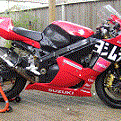-
Posts
885 -
Joined
-
Last visited
Profile Information
-
Gender
Male
-
Location
Wiltshire
Recent Profile Visitors
The recent visitors block is disabled and is not being shown to other users.
Kev The Modeller's Achievements

Obsessed Member (4/9)
515
Reputation
-
Kev The Modeller started following Flexable airbrush hose ? , Halberstadt CL.II , Tamiya 1/48 Aichi M6A1 Seiran and 7 others
-

how do you hold small/tiny parts when they need to be sanded?
Kev The Modeller replied to DD_Crash's topic in Modelling Tips
Depending on how thick the flashing is, use some Tamiya extra thin quick setting cement. It will just melt the flashing away. -
I had Zap, pink, green and yellow CA. I never used the first 2 just the yellow, until it wouldn't set even with accelerator, I opened the other 2 they too wouldn't set. They had all gone off, absolutely no cling whatsoever, I then discovered CA has a shelf life of approximately 18 - 24 months. They were less then a year old (to me) but obviously been sitting on the sellers shelf and there no date info on the bottles. Wasted about £20. I now just but the little tubes of gel as and when saves wasting anymore money.
-
I agree there is a lot of crossover. I found this very useful. If you still think you like more specific guidance go for or one of AVF/aircraft encyclopedias sets they do, you can just buy indualvidual volumes if you feel you don't need the whole set.
-
I've not had any brush painting issues with them. I don't do much or really large areas, straight out of the bottle, onto a wet palette, on the the surface, couple coats done.
-
As mentioned above take a look at air-craft these are top quality made to your spec fittings/length etc. I've got a couple, very flexible, beautifully finished
-

I should get a spray Booth, what should I be looking at
Kev The Modeller replied to Broadway's topic in Airbrushes
I've got something very similar, works a treat. Keeps aircurrents out, dust etc from settling on wet surfaces and heat/cold air out while airbrushing. Mine is attached with velcro, easily removed if needs be, that said the window will close with it inplace once the vent duct is removed. -

I should get a spray Booth, what should I be looking at
Kev The Modeller replied to Broadway's topic in Airbrushes
Yes I agree, my comment of a 'quality' vent/extractor is that anything less (those previously mentioned IMHO) isn't up to the job of capturing/filtering non water based acrylics, which @Broadway states he want to try/use. The other vents mentioned are up to handling water based acrylic but not solvent or high use alcohol based acrylics. -

I should get a spray Booth, what should I be looking at
Kev The Modeller replied to Broadway's topic in Airbrushes
If you're going to start using anything other than true water based acrylics like AK, Mig Ammo, Vallejo etc, longterm, Tamiya and Mr Hobby Aqueous acrylics are alcohol based. You're going to need a quality extraction booth/vent, especially if you wish to use lacquers i.e. Tamiya LP, Mr Color, AK real, etc and most true metallic paint. There's really only one way to go, it's not cheap but it the best and will last a lifetime BV300S-D Martin is out of stock right now, reason they're good and sell fast. I tried the Sparmax and Aircom vents both cheaper but they aren't up to the job with lacquers especially when airbrushing, larger scale kits. I could still smell the vapour forcing me to wear a mask and the room stunk for a good while afterwards, even with a window open, which isn't good when applying top or clear coats. With the BV I can spray all but Zero and Alclad without smelling an odor and then it's just a hint, they're pretty smelly paints very high solvent content. -

Bomber Task Force Deployment 2021- RAF Fairford
Kev The Modeller replied to Seamus's topic in Aviation Photography
Superb pictures, thanks for sharing -
Yes me too, got rid of Mac, Norton, AGV you name it, all of which cause more issues than they solve. My system runs faster and I've had no issues whatsoever for about 5 yrs or so. It's also free.
-
This is sadly a too common issue with Airfix. I like many, grew up on their kits but I wouldn't touch one now just too hit and miss with customer service. It's all about profit above all else.
-

Airfix 1/144 SR.N4 (09171)
Kev The Modeller replied to davecov's topic in Ready for Inspection - Maritime
I always wanted one of these, sadly pocket money wouldn't stretch. These were amazing craft, running (fuel) and maintenance costs killed them, as they couldn't carry enough and of course cut price ferry prices at the time, I believe. I was lucky enough to go on one in Nov 1999, a Hoverspeed SR.N4 from Dover to Calais, I think they stopped running they following year. -

Take 2 - Trumpeter 1/350 HMS Hood
Kev The Modeller replied to MRMRL's topic in Ready for Inspection - Maritime
Lovely clean build -
It's a no brainer as far as I'm concerned, soldering is the way to go. Tin each part/section first, position with clips or plasticne etc and all that will be needed is a quick touch of very local heat for a solid join. The key to is quality, solder/flux and soldering iron and cleaning the areas to be soldered. Do a good few practice runs on scrap PE of varying shapes and thicknesses until you get a result time after time, the heat required once properly tinned is just a touch of the correctly heated soldering tip.



